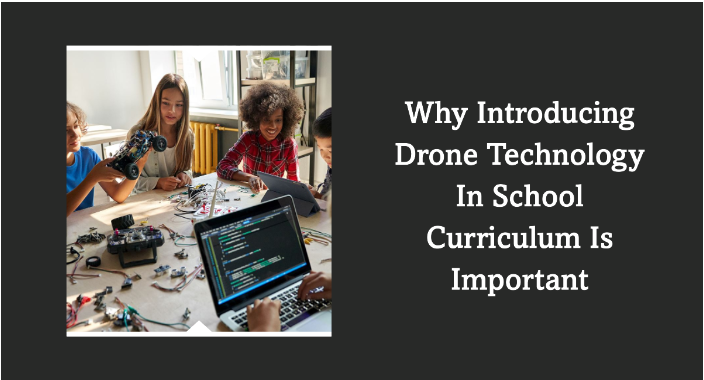Most school curriculums have STEM education, which stands for Science, Technology, Engineering, and Mathematics. According to research, more than half of American students don’t pursue STEM courses as they are considered academically challenging.
However, introducing drone technology into the school curriculum can help more students take and pass STEM courses.
Drone technology is the design and development of drones, which can be controlled by humans or programmed. Introducing this technology in the school curriculum will help the kids gain practical experience, which makes the learning process easier.
Continue reading the article below to learn why introducing drone technology into your school curriculum is essential.
1. Enhances Problem-Solving Skills
One significant reason why introducing drone technology in your school curriculum is essential is that it enhances problem-solving skills among learners. Flying a drone requires knowledge about the weather and the surrounding environment. For instance, the perfect weather condition to fly a drone includes clear skies, calm winds, and adequate light.
Therefore, when a learner wants to fly a drone, they will ask themselves whether the conditions are perfect for flying a drone. Knowing such things will help them make the right decision, especially when encountering a problem while flying the drone.
Furthermore, the learners can enhance their problem-solving skills by coding various commands for the drone to execute. Also, schools and universities have started focusing on the advancements in drone technology and how programmable drones for schools are helping them learn new technologies.
2. Promotes Creativity
After introducing drone technology as a subject to students, you can assign them fun projects to do. These projects may include drawing a map of where you want to fly the drone. Also, taking photographs of the home or school compound where they can fly drones without obstructions.
This helps the kids be more creative, as they may have different project ideas.
Also, another way drone technology promotes kids’ creativity is by allowing them to customize their drones according to their liking. This is a simple and fun task, as drones are customizable. For instance, you can customize the flight controllers based on their desirable features. The frames are also customizable, as you can use materials based on your preferences.
3. Provision Of Hands-On Experience
Drone technology involves assembling various hardware components, which is the best exercise for providing kids with hands-on experience. With this experience, the students will know what happens in the manufacturing stage when making drones.
Additionally, hands-on experience will make them more marketable in the job market after they finish school.
Moreover, the students can develop piloting skills by including drone technology in school. This involves navigating basic drone controls such as throttle, pitch, and yaw. The throttle control adjusts the power generated by the drone’s motor. In addition to that, the pitch is used to move the drone forward and backward while the yaw controls the drone’s rotation.
4. Practical Introduction of Programming to School Children
Most students consider programming challenging as it involves coding a series of instructions in a form that machines can understand. Also, fixing bugs can be a painstaking and tiring process.
However, introducing drone technology to students in school can make them easily master programming while still young.
Drone technology heavily relies on programming for planning flights and customization. Also, the safety and regulatory compliance of drones is done through programming.
Hence, students can easily master programming, as they can customize the drones to do various exciting tasks, such as doing an acrobatic stunt. They can also program drones to perform flying tricks like flips and rolls. This way, students can master and improve their programming skills.
5. Practically Explains Maths and Science Concepts
Like programming, most students need help to grasp maths and science concepts. This is because maths and science involve complex theories that may be hard to comprehend and visualize. In addition, some students may need more interest in science and maths, making them perceive the subject as harder.
However, introducing drone technology in the school curriculum will make these subjects fun, as it involves visualizing theoretical concepts. Studies show that learners are likely to develop an interest in areas where visualizations are used to explain theoretical concepts.
Therefore, with drone technology, learners can have theoretical classes on how drones operate. After that, they can apply that knowledge to flying drones, which makes them understand the concept better.
6. Improves Physical Activity and Social Interactions
Due to safety precautions, drones need an open space to fly, allowing them to maneuver easily without any constraints. Also, there are drone regulations that only allow them to be flown in some areas and not others, such as near airports, as it is prohibited.
In most cases, open spaces such as parks and open fields are always shared. Therefore, when students come out to fly their drones, they will be exercising while interacting with each other, thus promoting social interactions.
Physical activity is promoted when the learners execute different tricks on their drones. This also helps improve their hand-eye coordination and motor skills. In addition, drone flying can be coupled with other outdoor activities, such as hiking, which is also a physical activity.
7. Promotes an Understanding of Electronics and Sensors
Finally, introducing drone technology into your school curriculum will promote an understanding of electronics and sensors. This is because, to achieve stable flights, drones are equipped with sensors and electronics.
The sensors provide essential information to the controller, which helps it make data-driven and informed decisions that are used to adjust the flight parameters of the drone. Therefore, the learners can conduct practical experiments to understand how sensors like accelerometers and gyroscope work.
Furthermore, they will learn and explore more about the electronics used in drones, such as motors.
Final Thoughts
Drone technology is the future of recruiting more students to learn STEM subjects. This is because the learners can easily comprehend theoretical concepts after doing them practically.
Also, drone technology improves physical activity and social interactions among learners as they are designated places to fly your drone. Such places include open areas such as parks and open fields. You can also fly your drone in empty landscapes, such as deserts without buildings or trees.
All in all, learners can further understand the importance of electronics and sensors while learning about drone parts. Understanding such concepts helps prepare them for the job market as they will be equipped with the needed knowledge and skills.




